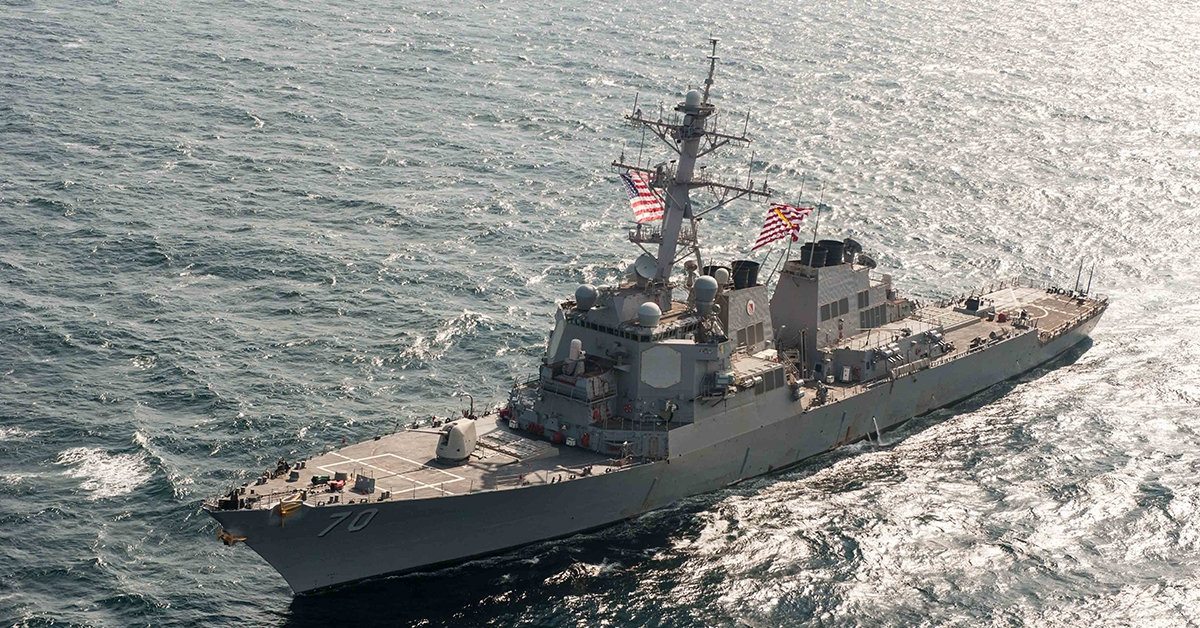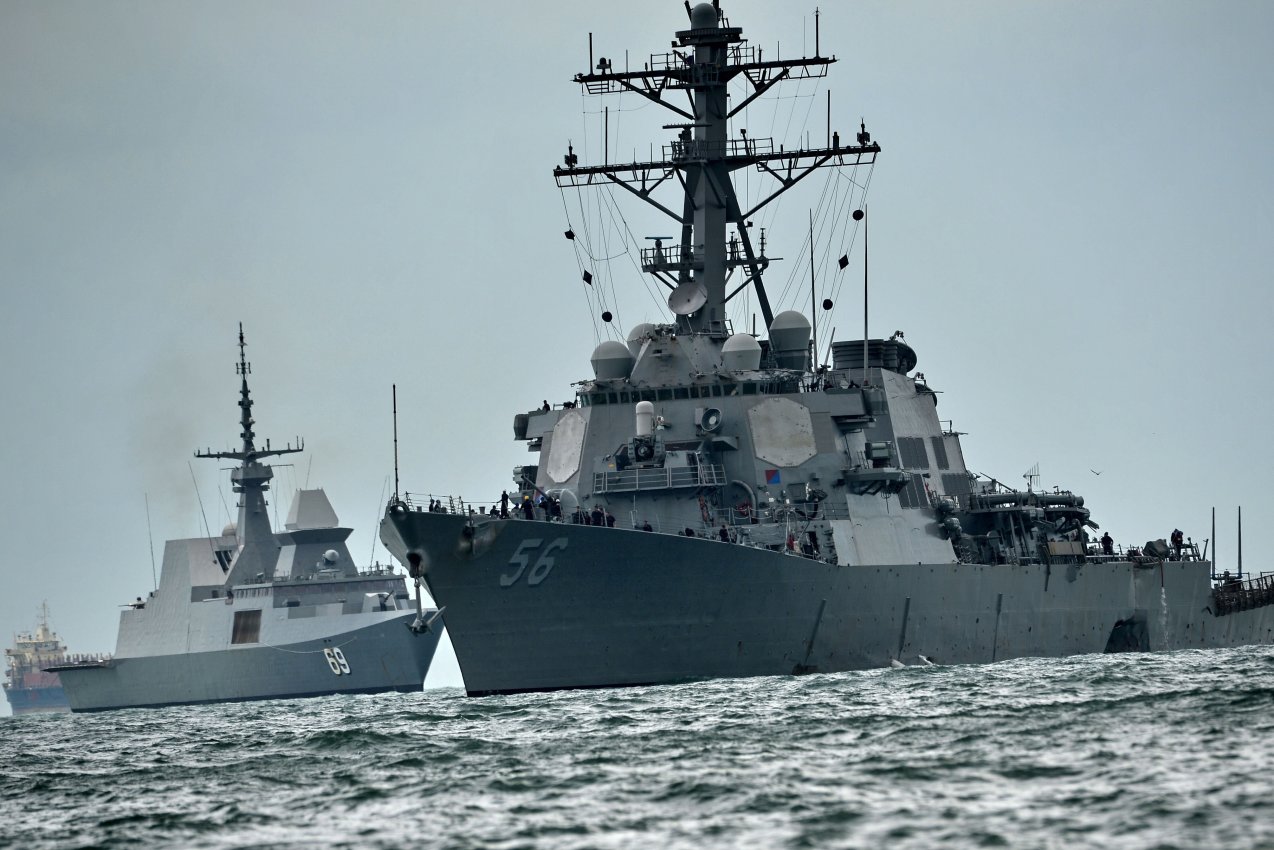Trump Had Big Plans for the Navy. What’s Happened?
Apr 7 2018The moment Donald Trump took office, the U.S. Navy pressed him to keep his word. While campaigning, the future president had pledged to expand the fleet to the 355 front-line warships the Navy and its supporters had been urging for years to meet the new threats posed by Russia and China. The cutback after the end of 
The USS Hopper, Active in affirming freedom of navigation in the South China Sea.
the Cold War, when Reagan-era spending boasted a fleet of 594 ships, 15 of them carriers, had left the Navy with a mere 275 ships, a total inadequate to the demands placed on it to patrol the world's seas.
The Navy had at the ready its "Force Structure Assessment" that called for building out the fleet with more carriers, submarines, destroyers and amphibious assault ships. They declared their plan "executable". Their "2018 Navy Shipbuilding Plans" was already in the works. Implementation would be subject to Congressional budget allocations, of course, but a stronger military was Republican doctrine and the government — from White House to Capitol Hill — was now under Republican control.
True to plan, in mid-December, Congress passed and President Trump signed the 2018 National Defense Authorization Act which made a 355-ship Navy national policy, to be achieved "as soon as practicable". To meet the global needs of combatant commanders the Navy assessment for 2018 called for 12 carriers, 104 large surface combatants, and 66 attack submarines.
Yankee go homeThe Navy's concerns are justified. Both Russia and China chafe at the United States setting the rules of a world order and the effrontery of our navy projecting its power wherever it chooses, from the Black and Baltic Seas bracketing Russia, to the seas wrapping China. President Vladimir Putin wants to restore some of the
glory of the vast Soviet Union, the loss of which he has described as "the greatest geopolitical tragedy of the [20th] century". China's military doctrine has pivoted from "the traditional mentality that land outweighs sea", replaced by “Great importance has to be attached to managing the seas and oceans".
China is bent on surpassing U.S. power, one aspect being to control their surrounding waters. The scope goes well beyond the shoals and rock formations in the South China Sea that have been built out with barracks and runways for fighter jets. China has a long-held and secretive plan that shows up on certain maps — a series of dash lines drawn ever-outward from their coastline, the first to embrace a number of island chains of disputed ownership claims, the second further into the Pacific encompassing as far as America's Guam, the third far deeper into the Pacific to butt up against the Aleutians and Hawaii. Americans would do well to become aware of the ominous intention to drive the U.S. from the Pacific. We covered this is in our 2015 series "War With China: Is It Already Here?", "China’s Master Plan: Drive Us Out of 'Their' Pacific", and "China's Military Build-up — It's Aimed at Us".
shrinking pains
In trying to do as much as before with too few ships, the Navy has invited a slew of problems. There had been three reports across two years by the Government Accountability Office warning of an over-extended Navy that, despite an 18% fleet reduction since 1998, had kept up its regimen of 100 ships always overseas. Carrier-based F/A-18 fighters were in the air 8,000 or 9,000 hours against their rated lifespan of 6,000 hours. Combat aircraft stayed on the ground or on deck for lack of spare parts. Too little time had 
been dedicated to training crews. Sailors arrived at their ships with inadequate skills and were then worked an average of 108 hours a week instead of the Navy's standard 80-hours. When in port, the Navy has traditionally put its sailors through months of 3-to-5 week courses to teach them the seafaring skills that have made it the world's best navy, yet the GAO report said that ships based in Japan had “no dedicated training periods”. In September, the GAO told the House Armed Services Committee that more than a third of the ships in the Japan-based Seventh Fleet had expired warfare-training certifications.
Deployments had been stretched from the standard six months away from home per 18-month period to nine months or longer, wearing on both ships and sailors. Maintenance had been deferred or eliminated.
The deficiencies came to light after four incidents in a year, culminating with two collisions last June and August that left 17 sailors dead or missing.

The USS John S. McCain, with a hole after a collision, being escorted to Singapore
Afterward, the media reported these shortcomings, but without much mention of the ships' command responsible for the ships and the crew's lives. At any moment there's the exec officer on the bridge if not the captain, radar operators, navigators, crew standing watch in harbor approaches, computers calculating other ships' speed and direction. So how lax must have been the command discipline for these collisions to have happened? Lax enough, evidently, for the Navy to announce in January the court-martial of the officers who commanded the ships and charge them with negligent homicide, dereliction of duty, and hazarding their vessels.
It is with this overworked Navy, these mishaps having raised questions about its readiness, that the U.S. is testing China's claims that the South China Sea is its private lake. A U.S. destroyer, making one of many freedom of navigation statements, just sailed within 12 miles of one of the Spratly Islands on which China has built a base well offshore of its mainland. Twelve miles is the closest the laws of the sea allow a ship to come to the land of another sovereign nation without permission; the U.S. does not honor China's claim that the Spratlys belong to them. China called the sail-by "a serious political and military provocation". This was a repeat of a January sail-by of Scarborough Shoal, another of China's build-outs, and one far closer to the Philippines than China. (Philippine President Rodrigo Duterte, with whom President Trump says he has a "great relationship", has turned his back on the U.S. and caved in to China, no longer protesting these island takeovers). In the January incident, China says our ship was chased off by one of its frigates. True or not, it says that a clash is inevitable if we elect not to allow China to re-write the rules of the open sea.
Chinese scholars point to our Monroe Doctrine in defense of their newly aggressive posture in the South China Sea. It is an inapt comparison. The U.S. was defending the continent from European moves to thwart South America's quest for freedom from colonization, whereas China's moves to block U.S. patrols are the opposite — to end freedom of passage by all navies and commercial shipping.
a naval build-upWith a production rate five times that of the U.S. and a projected 78 submarines by 2020, the Chinese have partly opted for the quantitative advantage of cheaper diesel-powered boats. But by 2008 China already had an estimated 30 advanced, partly-stealthy subs and has since sent down the ways their first "boomer" submarine armed with nuclear missiles having a range of 4,500 miles that can reach Alaska or Hawaii — or the continental United States, if launched from out in the Pacific.
But if a contest flares up over control of its near seas or Taiwan, the Chinese mainland makes possible a hybrid land-sea war. China's coast guard is outfitted with military weaponry, it has unmarked coastal warships, and China can deploy cyber attacks from land. They have precise cruise missiles, sophisticated mines, the aforementioned subs, and the DF-21D shore-to-ship missile. It can be launched from a truck, fly almost 1,000 miles over the ocean, and home in on a ship moving at 30 knots — a chilling threat to a carrier with over 5,000 men and women and 60-70 aircraft — and we need add, taking years to replace at a cost of $10-or-so billion. The Pentagon cannot be sure the DF-21D truly works but in 2007 a DF-21D variant destroyed an obsolete weather satellite that was orbiting the planet. The Navy is betting on its iffy ability to detect, track and destroy an incoming DF-21D for which the best they could hope for is an estimated window of 12 minutes — and only if they were that full 1,000 miles away.
Russia reaching outRussia's navy may be smaller than the U.S. Navy but they plan to build 100 ships by 2020 with technology that will perforce exceed that of our older ships. Their plan will augment a growing nuclear submarine force that is already first rate, as are their surveillance systems, both from drones and space satellites. Russia has long-range cruise missiles that could menace our ships and Putin recently announced a nuclear torpedo that he claims will outsmart all American defenses. He may be bluffing, say some experts, but like China, it says that Russia has chosen wisely to emphasize anti-ship weapons.
As with China, Russia has stepped out aggressively. About 20 of those new ships are slated for the Black Sea; not for its beaches did Russia annex Crimea in 2014 with its ideally situated naval base at Sevastopol. 
Sevastopol, Crimea
In January, a Russian military jet buzzed an EP-3 Orion surveillance plane in international airspace over the Black Sea, coming to within five feet said its crew, forcing the U.S. Navy plane to end its mission.
Russia has big plans for its leased naval base in Syria at Tartus on the Mediterranean, from which a Russian ship supported its Syrian ground operations last year. Its ships range the North Atlantic and Baltic, the increasingly navigable Arctic, and both the U.S. coasts, from which its ballistic missiles and torpedoes pose a looming threat.
And from both these adversaries there is the threat of further asymmetric weapons already coming into being. War planners on all sides envision how swarms of "bots" — small drones — could be launched to seek out ships and deliver chemical or biological agents to kill their crews. To the degree that artificial intelligence (AI) is involved — for each member of the swarm to avoid the others as in a murmuration of starlings, or to find their prey — other nations have an advantage. When China's Xi Jinping or Putin goes to the private sector for assistance, they daren't say no. Not so America. China, announcing its Next-Generation Artificial Intelligence Development Plan, intends to become the "premier global AI innovation center" by 2030. Its funding of AI research dwarfs what the U.S. budget allocates. Putin has proclaimed artificial intelligence as the future. "Whoever becomes leader in this sphere will become the ruler of the world", he said. Whereas in the U.S., where the Pentagon is seeking help from Silicon Valley, the Google subsidiary that developed the AI software that defeated a Go grandmaster refuses to work with the military.
is the 355-ship navy happeningThe foregoing outlines the situation the U.S. Navy faces. The question is whether the 355-ship Navy, consecrated as official policy, has become only a fond aspiration unrelated to fact. In January The Wall Street Journal took a look at December's defense authorization act and concluded that shipbuilding was only following its usual spending pattern. And now we have the $1.3 trillion spending bill, signed just before Congress took its Easter break, that actually tells us what money has been committed to plan. It provides for only a $2.3 billion increase in shipbuilding over 2017. It's a roster of 14 ships: one carrier, two DDG-51 guided missile destroyers, two Virginia-class submarines, three littoral combat ships; one expeditionary sea base; one expeditionary fast transport; one amphibious ship; one fleet oiler; one towing, salvage, and rescue ship, and one oceanographic survey ship. Both the carrier and the amphibious ship are replacements of existing ships, not additions to the fleet. And as is apparent, only seven of the remaining 12 are new combat ships. This is not a pace that will reach 355 ships anytime soon, and it falls far short of the pace of Russia and China reported above.
Which raises the question of whether Defense Secretary James Mattis and the Trump administration have quietly concluded that the Navy's chief role is for its worldwide presence, the projection of an image of power rather than actual power, in the realization that the Navy holds ever-weakening odds in the face of guided missiles that can cover a thousand miles and fast, autonomous torpedoes that can hunt in packs like wolves — all of which are far cheaper than ships. Will we see the aircraft carrier — that majestic emblem of our rule of the seas — go the way of the battleship?
Please subscribe if you haven't, or post a comment below about this article, or
click here to go to our front page.


Most comprehensive article on the subject I’ve come across. Daniel Ellsberg stated recently that the deterrent of our entire ICBM collection, and I’ll assume the bloated navy would be in this category, could be duplicated by an extra few nuclear submarines.
These, unlike anything else, are undetectable, so they could be the deterrent that is the only way to prevent the kind of war that would use the full navy described. Aircraft carriers could all be taken out in a first strike, and they needn’t be nukes, as the kind of biological weapons that was used in London could incapacitate the crew of the ships.
It’s this century’s version of Ike’s “military, industrial, congressional complex” still with us, but even less useful and more financially ruinous.
Carriers, in an all out war, today will disappear within minutes of the start of said war. Carriers still, in terms of force projection, have their value, much as battleships would. As a famous admiral once said, “ when one of these big bastards sails into the offending countries harbour it really makes them think twice about who they’re screwing with if this is just the messenger they sent”s